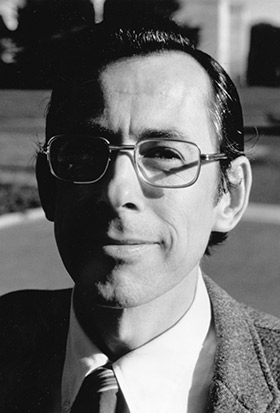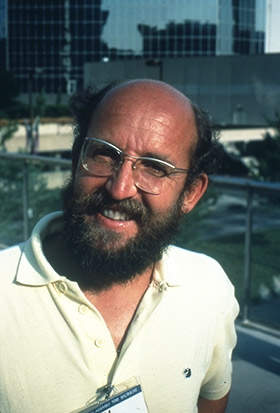AIP congratulates James Peebles, Michel Mayor and Didier Queloz on being named the winners of this year's Nobel Prize in physics "for contributions to our understanding of the evolution of the universe and Earth's place in the cosmos." Peebles receives one-half of the prize "for theoretical discoveries in physical cosmology" and Mayor and Queloz share one-half "for the discovery of an exoplanet orbiting a solar-type star."
This page will be populated with the information and resources about the 2019 Prizes and the newly named laureates.
Updates coming throughout the day

From AIP Leadership
Statement from Michael Moloney, AIP’s CEO
"AIP is delighted to congratulate James Peebles, Michel Mayor, and Didier Queloz on being awarded this year’s Nobel Prize in physics," said Michael Moloney, the chief executive officer of AIP. "Their groundbreaking work on discovering the fundamental nature of the universe and new worlds in distant solar systems has opened up whole new areas of research in cosmology and exoplanet science. The discovery of a planet orbiting a star outside our own system has changed our perceptions of our place in the universe—a universe that still holds many mysteries to solve.”
Statement from Steve Mackwell, AIP’s DEO
“Today’s announcement of the 2019 Nobel Prize in physics highlights the critical role of astrophysical theory and observations in redefining our understanding of the evolution of the universe and our place in it,” said Steve Mackwell, deputy executive officer of AIP. “AIP congratulates James Peebles, Michel Mayor and Didier Queloz for their seminal work that has changed our view of the cosmos.”
Overview
The discoveries celebrated by this year’s Nobel Prize are focused on dark and light.
After about 400,000 years of expansion and cooling following the Big Bang, the universe became transparent to light when the first atoms formed -- atoms from which all the visible universe today is derived.
Now, more than 13.7 billion years later, we know that our galaxy, and likely others, is bright with light from stars which are bountiful with planets. We know that about 5% of the universe is made up of the matter we can see in galaxies and the vastness of intergalactic space. But the other 95% is a dark mystery.
Separating the dark …
Albert Einstein first predicted in 1917 what we now call dark energy. By the time discoveries relating to dark matter and dark energy won Nobel Prizes in 2006 and 2011, scientists had learned that dark energy makes up 68% of our known universe and dark matter about 27%.
Since before the first measurements of what we now call the cosmic microwave background, James Peebles was developing a theoretical framework for understanding the origins and evolution of the cosmos. His work connected the CMB with the predicted consequences of the Big Bang and helped change fundamentally our understanding of the universe including the existence of missing, dark components. He is awarded one-half of this year’s Nobel Prize in physics for his theoretical discoveries in physical cosmology.
… from the light
Contrasting Peebles’ contributions to our knowledge of the dark universe, Michel Mayor and Didier Queloz share one-half of the Nobel Prize for their cosmic discovery by making precision measurements of light from a sunlike star in our galaxy.
About 50 light-years away in the Pegasus constellation, a planet orbits a star like our own sun. In 1995, Mayor and Queloz noticed a subtle red- and blue-shifting of the light from this star, characteristic behavior of a star being wobbled by an orbiting planet.
This was the first discovery of an exoplanet orbiting a solar-type star. Today we have evidence for the existence of over 4,000 such planets.
What was particularly surprising about this observation was how different the size and orbit of this planet -- 51 Pegasi b -- are from those of any planet in our solar system. It is large and hot but close to its star with a very short orbital period. This was unexpected to astronomers who had predicted other solar systems to look somewhat like ours -- smaller rocky planets closer to the sun and cool, large, gaseous planets further out.
This discovery opened the door to learning there are many different types of planetary systems in the universe. There may be billions of planetary neighbors in our own Milky Way -- some of which are likely to harbor the potential for life.
The discoveries of Peebles, Mayor and Queloz paint a new picture of our universe and our understanding of our place in it.
From Inside Science
Three Share Physics Nobel for Exoplanet and Cosmological Discoveries
All the Exoplanets That Came Before 1995
2019 Physics Nobel Prize AIP Publishing Journal Articles →
2019 Physics Nobel Prize AIP Member Society Resources →
2019 Chemistry Nobel Prize Resources →
From Physics Today -- Free access for a limited time
Peebles, Mayor, and Queloz share 2019 Nobel Prize in Physics
Biographies
James Peebles
Born in 1935, Peebles is a Canadian American theoretical cosmologist and physicist. Currently Albert Einstein Professor Emeritus of Science at Princeton University, Peebles has dedicated his career to the study of physical cosmology. He made major contributions to understanding of cosmic microwave background radiation, dark matter and dark energy, cosmic structure formation and the Big Bang model. He is the winner of numerous awards, including the Gold Medal of the Royal Astronomical Society and Dannie Heineman Prize for Astrophysics. In 1993, he published his book Principles of Physical Cosmology.
https://www.aip.org/history-programs/niels-bohr-library/oral-histories/4814
Michel Mayor
An active researcher at the Observatory of Geneva, Mayor is a Swiss astrophysicist and professor emeritus at the University of Geneva’s Department of Astronomy. Mayor discovered 51 Pegasi b in 1995 with Didier Queloz. Mayor was born in 1942 and earned a master’s degree in physics at the University of Lausanne and a doctorate in astronomy from the Geneva Observatory.
https://www.nobelprize.org/prizes/physics/2019/mayor/facts/
Didier Queloz
Queloz was awarded this year’s Nobel Prize for his research and co-discovery of exoplanet 51 Pegasi b, with Michel Mayor while a graduate student at the University of Geneva. He is a Swiss astronomer known for identifying extrasolar planets. He is now professor of physics at the Cavendish Laboratory and Geneva University. In addition to the 2019 Nobel Prize, Queloz has been awarded the Wolf Prize in Physics and the BBVA Foundation Frontiers of Knowledge Award of Basic Sciences.
https://www.astro.phy.cam.ac.uk/directory/prof-didier-queloz
From the AIP Physics History Network


Niels Bohr Library & Archives resources on Peebles and Mayor:
James Peebles
Oral History Interviews:
https://www.aip.org/history-programs/niels-bohr-library/oral-histories/4814 (9/27/84)
https://www.aip.org/history-programs/niels-bohr-library/oral-histories/25507-1 (two sessions: 4/4/02-4/5/02)
https://www.aip.org/history-programs/niels-bohr-library/oral-histories/33957 (1/19/88)
Peebles in the Library Collections
Peebles in the Archival Collections
Peebles in the Emilio Segre Visual Archives
Michel Mayor
Mayor in the Library Collections
Mayor in the Emilio Segre Visual Archives
